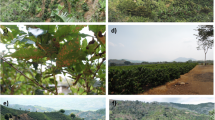Abstract
Tim Low’s article “Australian acacias, weeds or useful trees” criticizes aid and development agencies for planting and promoting agroforestry and forestry trees, like Australian acacias, across the world, highlighting evidence that several species have become problematic biological invaders. We propose an alternative to Low’s blanket condemnation, emphasizing the importance of the regional socio-ecological context, taxon specificity, and participatory political process. We address flaws in Low’s case that all wattles should always be judged dangerous, and ask who should make judgements—and on what basis—on whether people can diffuse plants across ecological barriers. Context-specific, socially debated and environmentally responsible diffusion of alien plants can amply satisfy the sustainable development goal of meeting the needs of the present while safeguarding those of the future.
Similar content being viewed by others
References
Aitken M, Rangan H, Kull CA (2009) Living with alien invasives: the political ecology of wattle in the eastern highveld Mpumalanga, South Africa. Étud Océan Indien 42–43:115–142
Beinart W, Middleton K (2004) Plant transfers in historical perspective: a review article. Environ Hist (UK) 10:3–29
Brockway LH (1979) Science and Colonial Expansion. Academic Press, New York
Brown JH, Sax DF (2004) An essay on some topics concerning invasive species. Austral Ecol 29:530–536
Carruthers J, Robin L, Hattingh JP, Kull CA, Rangan H, van Wilgen BW (2011) A native at home and abroad: the history, politics, ethics and aesthetics of Acacia. Divers Distrib 17:810–821
Castro-Díez P, Godoy O, Saldaña A, Richardson DM (2011) Predicting invasiveness of Australian acacias on the basis of their native climatic affinities, life history traits and human use. Divers Distrib 17:934–945
Colautti RI, MacIsaac HJ (2004) A neutral terminology to define ‘invasive’ species. Divers Distrib 10:135–141
Crosby AW Jr (1972) The columbian exchange. Greenwood Press, Westport, CT
Davis MA (2009) Invasion biology. Oxford University Press, Oxford
de Neergaard A, Saarnak C, Hill T, Khanyile M, Berzosa AM, Birch-Thomsen T (2005) Australian wattle species in the Drakensberg region of South Africa—an invasive alien or a natural resource? Agric Syst 85:216–233
Griffin AR, Midgley SJ, Bush D, Cunningham PJ, Rinaudo AT (2011) Global uses of Australian acacias—recent trends and future prospects. Divers Distrib 17:837–847
Jose S (2011) Managing native and non-native plants in agroforestry systems. Agrofor Syst 83:101–105
Kull CA, Rangan H (2008) Acacia exchanges: Wattles, thorn trees, and the study of plant movements. Geoforum 39:1258–1272
Kull CA, Tassin J, Rangan H (2007) Multifunctional, scrubby, and invasive forests? Wattles in the highlands of Madagascar. Mt Res Dev 27:224–231
Kull CA, Shackleton CM et al (2011) Adoption, use and perception of Australian acacias around the world. Divers Distrib 17:822–836
Larson BMH (2005) The war of the roses: demilitarizing invasion biology. Front Ecol Environ 3:495–500
Larson BMH (2007) An alien approach to invasive species: objectivity and society in invasion biology. Biol Invasions 9:947–956
Latour B (1986) Laboratory life: the construction of scientific facts. Princeton University Press, Princeton
Low T (2002) Feral future. University of Chicago Press, Chicago
Low T (2003) The new nature. Penguin, Camberwell
Low T (2012) Australian acacias: weeds or useful trees? Biol Invasions (In press)
Pfeiffer JM, Voeks RA (2008) Biological invasions and biocultural diversity: linking ecological and cultural systems. Environ Conserv 35:281–293
Pollan M (2001) The botany of desire. Bloomsbury, London
Rangan H, Carney J and Denham T (2012, in press) Environmental history of botanical exchanges in the Indian Ocean World. Environ Hist (UK)
Richardson DM, Binggeli P, Schroth G (2004) Invasive agroforestry trees: problems and solutions. In: Schroth G, Da Fonseca GAB, Harvey CA, Gascon C, Vansconcelos HL, Izac A-MN (eds) Agroforestry and biodiversity conservation in tropical landscapes. Island Press, Washington, pp 371–396
Richardson DM, Carruthers J, Hui C, Impson FAC, Miller JT, Robertson MP, Rouget M, Le Roux JJ, Wilson JRU (2011) Human-mediated introductions of Australian Acacia species—a global experiment in biogeography. Divers Distrib 17:771–787
Robbins P (2001) Tracking invasive land covers in India, or why our landscapes have never been modern. Ann Assoc Amer Geogr 91:637–659
Robbins P (2004) Culture and politics of invasive species. Geogr Rev 94:iii–iv
Scott JC (1998) Seeing like a state. Yale University Press, New Haven
Shackleton CM, McGarry D, Fourie S, Gambiza J, Shackleton SE and Fabricius C (2007) Assessing the effects of invasive alien species on rural livelihoods: case examples and a framework from South Africa. Hum Ecol: 113-27
Starfinger U, Kowarik I, Rode M, Schepker H (2003) From desirable ornamental plant to pest to accepted addition to the flora?—the perception of an alien tree species through the centuries. Biol Invasions 5:323–335
Tassin J, Rangan H, Kull CA (2012) Hybrid improved tree fallows: harnessing invasive legumes for agroforestry. Agrofor Systems. doi:10.1007/s10457-012-9493-9
Warren CR (2007) Perspectives on the ‘alien’ versus ‘native’ species debate: a critique of concepts, language and practice. Prog Hum Geogr 31:427–446
WCED (1987) Our common future. Oxford University Press, Oxford
Wilson JRU, Gairifo C, Gibson MR et al (2011) Risk assessment, eradication, and biological control: global efforts to limit Australian acacia invasions. Divers Distrib 17:1030–1046
Acknowledgments
We thank Dave Richardson for leading the Stellenbosch acacia workshop and inviting an ecumenical set of participants. We thank Charlie Shackleton, Rod Griffin, Libby Robin, Tony Rinaudo, Jane Carruthers, and Haripriya Rangan for their insights on this paper; however, the final contents remain our own responsibility.
Author information
Authors and Affiliations
Corresponding author
Rights and permissions
About this article
Cite this article
Kull, C.A., Tassin, J. Australian acacias: useful and (sometimes) weedy. Biol Invasions 14, 2229–2233 (2012). https://doi.org/10.1007/s10530-012-0244-7
Received:
Accepted:
Published:
Issue Date:
DOI: https://doi.org/10.1007/s10530-012-0244-7




